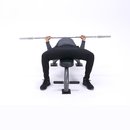Which would serve you better in life: mastering calculus, anthro - or how to build a perfectly sculpted chest?
Unless you're launching rockets or digging up ruins for a living, you'd probably choose the latter.
If colleges offered a course on pec building - call it Chest 101 - it might go something like what I'm about to teach you. This isn't like the information you'll receive from any old magazine, or any old trainer, or bro-science from your roommate. This is legit science-based, gym-tested data designed for surefire results.
When you click play, you also see how I use resistance bands and other advanced techniques to create the ultimate guide to building amazing pecs. Follow this and you'll get an A+!
See, I was once like you - that is, if you have puny little pecs. And I tried all sorts of different routines and methods to build up my chest. Sadly, none of them worked as well as I wanted.
Through my own trials and experimentation, I learned that my chest responded best to low reps of heavy pressing movements, the sort of stuff normally done by powerlifters, not bodybuilders. When I say low reps I am talking about 3-5 heavy reps.
So why did training with low reps lead to chest growth when higher reps didn't? Training with heavy weights for low reps stimulates more motor units and therefore more muscle fibers than training with lighter weights.
Gym Class In Session
Okay, time for a little science. Muscle contractions are signaled by action potentials (electrical signals) in the plasma membranes of muscle fibers. This signal is transmitted by nerve cells, known as neurons, from the central nervous system (CNS) to the muscle fiber. Nerve cells that innervate muscle fibers are called motor neurons.
A motor neuron originates in the CNS and spans to a muscle, where it divides into multiple branches. Each branch forms a junction with a single muscle fiber. A motor neuron plus all the muscle fibers innervated by its branches is known as a motor unit. Muscle fibers of a motor unit are all the same type of fiber (fast or slow twitch). Motor units are recruited according to the "Size Principle", which states motor units are recruited from smallest to biggest. Type I slow twitch muscle fibers are small while type II fast twitch muscle fibers are larger.
When lifting a sub-maximal load, the smaller, slow twitch muscle fibers are recruited before the larger, fast twitch muscle fibers are called upon, if at all. When lifting a near maximal load, both the larger fast switch and smaller slow twitch muscle fibers are activated at the same time! You must lift heavy to fully stimulate the fast-twitch muscle fibers, which are the muscle fibers with the greatest force production and growth potential.
The more motor units you can activate equates to the stimulation of a greater number of muscle fibers. So how do you recruit the most motor units? By lifting HEAVY! So why not train heavy (i.e. 3 reps) on every set and every exercise? Because, while the slow twitch muscle fibers are recruited during near maximal lifts, they may not be fully "weighted" or stimulated. As bodybuilders who are after both size and strength, we want to fully stimulate ALL muscle fibers, which means we must do both low rep and high rep sets.
By Way Of The Band
To achieve these results, we'll be incorporating advanced techniques using resistance bands. Resistance bands offer a different stimulus for hypertrophy and strength than traditional free weight exercises.
For this workout, you'll need two different types of resistance bands:
- 2 ½" Width Heavy Resistance
- 1" Medium Resistance
I recommend using SPRI SUPERBAND. The SPRI Superband is thick, extra strong and ideal for heavy duty use.
Derek "The Beast" Charlebois' Hardcore Chest Workout
EXERCISE 1 Barbell Bench Press
7 sets of 3 reps
Start with lighter weight and add 20 lbs. to each set, building up to your max weight for 3 reps.
Resting a full two minutes between sets will allow you to maximize recovery and strength, to lift the most weight possible for the next set.
Using a Power Rack setup for a power-lifting style bench press is good because it has safety bars which allow you to lift heavy weight safely without a spotter. It's always best to have a spotter, but if you don't you can still perform this type of bench press on the Power Rack.
EXERCISE 2 Reverse Band Bench PRess
5 sets of 5 reps
Keep the weight the same as where you left off on bench press, and attach the 2 ½" width bands to the barbell. Watch the video for instructions on how to properly attach the bands.
With the next four sets, continue adding weight in 20 lb. increments, until you reach your max set of 5 reps.
Setting up the bands at the top of the power rack causes the weight to decrease as you lower the bar due to the tension of the bands increasing as they are stretched. The weight increases as you press the bar up and the tension of the bands decreases. This allows you to overload the top of the bench press movement and increase lockout strength.
If you hit failure before 5 reps, that's the end of your set. You don't want to rack the weight and do a rest-pause or do a drop-set, you're done! The goal is to maximize performance with your max weight for each set.
Safety tip: Make sure to leave at least 135 pounds on the bar when taking the bands off, otherwise the bar will fling up in the air due to the tension.
EXERCISE 3 Incline Dumbbell Press
3 sets of 6-10 reps
While I am a big fan of lower rep training for hypertrophy I also feel that some higher rep work needs to be done in order to maximize muscle mass gains.
For me personally I find that my chest responds better using higher reps on incline pressing movements than using lower reps; using a lighter weight allows me to focus more on my form and really focus the tension on the clavicular head of the chest (upper pecs).
EXERCISE 4 Decline Barbell Bench Press
3 sets of 6-10 reps
Since we're using bands, you're going to have to use less weight than you normal would for this exercise, because the bands offer additional resistance.
Attach the 1" width bands on the support beams directly behind the handle where you push the weight. Watch the video for instructions on how to properly attach the bands.
As you push the weight forward, the bands stretch causing you to have to accelerate the weight faster. It also increases the eccentric portion of the movement, which increases muscle damage and can be helpful for muscle Hypertrophy (the increase of the size of muscle cells). Decline pressing movements target the sterna head of the pecs, commonly referred to as the lower chest.
Remember from your physics class, Force = Mass X Acceleration. In order to overcome the tension of the bands you must quickly accelerate the bars, requiring you to produce more force than you would have to without the bands.

BodyFit
$6.99/month- 2,500+ expert-created single workouts
- 3,500+ how-to exercise videos
- Detailed workout instruction
- Step-by-step workout tips
- Training at gym or at home
- Access to Workout Plans
- Access to Bodyfit App
- Store Discounts
Already have a Bodybuilding.com account with BodyFit? Sign In

What comes with BodyFit?

- Instructional Videos
Don't risk doing a workout improperly! Avoid injury and keep your form in check with in-depth instructional videos.

- How-to Images
View our enormous library of workout photos and see exactly how each exercise should be done before you give it a shot.

- Step-by-Step Instructions
Quickly read through our step-by-step directions to ensure you're doing each workout correctly the first time, every time.
Hardcore Warning
This workout is hardcore, and I recommend doing this workout once a week, for four weeks at a time for hardcore results. However, doing this workout for more than four weeks can lead to overtraining due to the added resistance from the bands.




